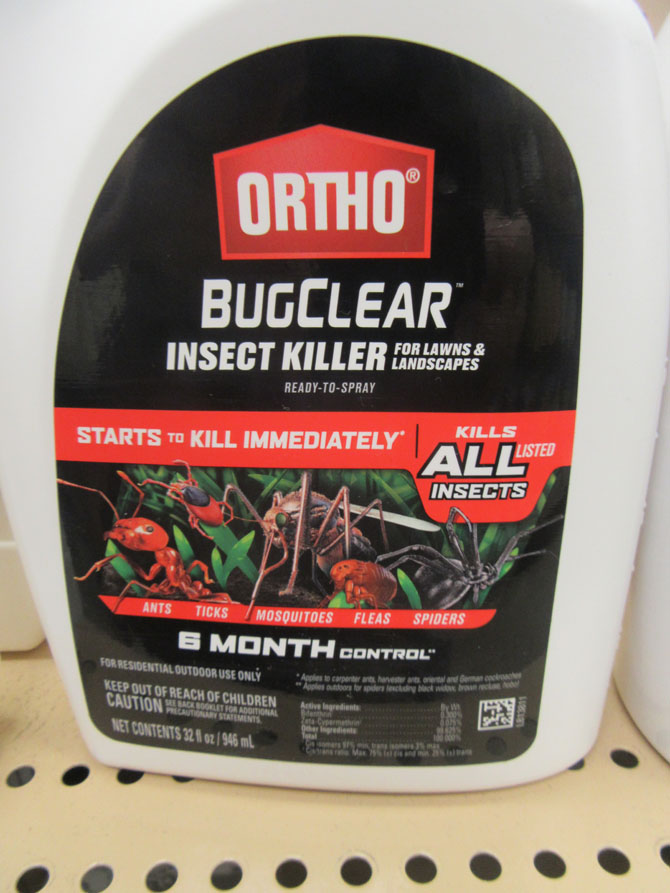Wednesday, August 14, 2024

Photo by Glenda Booth
Pesticides like these kill all insects exposed to the chemicals, including butterflies and caterpillars.
• Plant native milkweed and nectar plants. See https://www.pollinator.org/monarch/monarch-resources for appropriate plants.
• Create a monarch waystation, http://www.monarchwatch.org/waystations/.
Events
The Friends of Dyke Marsh butterfly walk, Aug. 17, www.fodm.org
Annual butterfly survey, Sept. 15, led by Larry Meade, www.nvbirdalliance.org
This summer’s heat and drought have not only taken a toll on humans, they may also be affecting the butterfly population. Some local naturalists believe there are fewer butterflies this summer in the region, but definitive conclusions cannot be reached until the season’s end in late fall.
Though Hurricane Debby brought some welcomed rain to Virginia, the drought could persist. Virginia had the driest June on record since 1895 according to Drought.gov.
And other factors may be involved.
Larry Meade conducts an annual butterfly survey and maintains, “Lower numbers are likely because of the heat and dry conditions. These are harsh conditions for caterpillars and there seem to be fewer flowers in the field than usual.”
Alexandrian Rod Simmons has also seen fewer butterflies this year than in past years.
Butterflies need plants for all of their life stages. The National Wildlife Federation explains, “The insects need places to lay eggs, food plants for their larvae (caterpillars), places to form chrysalides and nectar sources for adults … many butterflies and native flowering plants have co-evolved over time and depend on each other for survival and reproduction.” If plants dry up and die, the caterpillars and butterflies have less food.
Other factors can affect them too, like habitat loss, the ubiquity of non-native plants and pesticides that kill all exposed insects, not just the target insects. On mosquito spraying, for example, Elizabeth Train and Elizabeth Martin wrote in a recent article, “Pyrethroids, the main chemicals that mosquito services use to kill mosquitoes in residential yards, are a class of broad-spectrum insecticides that are acutely toxic to terrestrial invertebrates, including pollinators such as bees and butterflies. Mosquito sprays kill all insects, including the caterpillars that birds rely on to feed their young throughout the breeding season. Nearly all terrestrial birds (96 percent), even seed eaters, feed their nestlings insects.” https://www.nvbirdalliance.org/news/to-spray-or-not-to-spray
Meade is optimistic about this year’s butterflies, offering, “I think butterflies can bounce back. Insects are resilient, so with better conditions next year, they may well do better.”
Migration Miracle Is Underway
In late summer and early fall, monarch butterflies zigzag through the area en route to Mexico, joining millions to overwinter on oyamel fir trees at 9,000 to 11,000 feet. Observers estimate the size of the population by measuring the area of the forest occupied by overwintering monarchs.
The monarch is the only butterfly to regularly undertake a two-way migration. Monarch expert, the late Dr. Lincoln Brower called it “one of the most extraordinary annual migrations on our planet, an amazing migration that eludes explanation.” A western monarch population winters in California.
These orange and black butterflies, weighing 598 milligrams or one-fifth the weight of a penny, have evolved to lay their eggs on only one plant species, milkweed, called their host plant. English colonists named the insect for its colors, which reminded them of British royalty, the prince of Orange, later King William III.
When spring temperatures rise in Mexico and nectar sources become available, monarchs mate, head north and females lay eggs. The eggs become adults (see below for cycle) and this new generation flies north.
Under Stress
Jim Waggener leads butterfly surveys in Northern Virginia and observes, “We’re certainly seeing far fewer monarchs than usual. In the areas we’re surveying, monarchs are on track to have a very bad year, possibly — without a great pickup from fly-ins in the fall — a record bad year.”
University of Wisconsin-based Journey North tracks migrations and reported in February, “This past overwintering season was the second lowest on record but reports this spring and summer have been promising.”
On Aug. 4, Chip Taylor with Monarch Watch emailed, “I can’t tell you how big the migration will be. A lot depends on how many eggs were laid over the last 2.5 weeks north of 40 degrees latitude and then the forthcoming temperatures as that generation develops.”
For details, visit https://monarchwatch.org/blog/ .
The Monarch Cycle
Butterflies have four life stages. Females lay eggs on a leaf. After the egg hatches, the larva or caterpillar fattens up by eating leaves. That’s all they do -- eat milkweed. A monarch outgrows its outer skin or exoskeleton several times and attaches itself to a support by a silky adhesive substance and becomes a pupa, a green, bag-like chrysalis that dangles delicately and transforms into a butterfly. When the adult butterfly inside is fully formed, the chrysalis splits open, the butterfly pumps fluid into its wing veins, basks in the sun to dry, hardens its wings and takes flight.
Monarchs lay eggs exclusively on milkweed plants. Adult monarchs nectar or feed on a variety of plants. Nectar is especially important for fueling the fall migration.
Virginia has over 170 species of butterflies, reports the Department of Wildlife Resources.